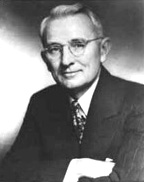Want to know how to stop worrying and start living?
Here’s a book from Dale Carnegie that I’ve sampled, a link to the Google Book page, and an excerpt on “How to Eliminate 50% of your Business Problems.”
“For fifteen years I spent almost half of every business day holding conferences, discussing problems. Should we do this or that-do nothing at all? We would get tense; twist in our chairs; walk the floor; argue and go around in circles. When night came, I would be utterly exhausted. I fully expected to go on doing this sort of thing for the rest of my life. I had been doing it for fifteen years, and it never occurred to me that there was a better way of doing it. If anyone had told me that I could eliminate three-fourths of all the time I spent in those worried conferences, and three-fourths of my nervous strain-I would have thought he was a wild-eyed, slap-happy, armchair optimist. Yet I devised a plan that did just that. I have been using this plan for eight years. It has performed wonders for my efficiency, my health, and my happiness.
“It sounds like magic-but like all magic tricks, it is extremely simple when you see how it is done.
“Here is the secret: First, I immediately stopped the procedure I had been using in my conferences for fifteen years-a procedure that began with my troubled associates reciting all the details of what had gone wrong, and ending up by asking: ‘What shall we do?’ Second, I made a new rule-a rule that everyone who wishes to present a problem to me must first prepare and submit a memorandum answering these four questions:
“Question 1: What is the problem?
(“In the old days we used to spend an hour or two in a worried conference without anyone’s knowing specifically and concretely what the real problem was. We used to work ourselves into a lather discussing our troubles without ever troubling to write out specifically what our problem was.)
“Question 2: What is the cause of the problem?
(“As I look back over my career, I am appalled at the wasted hours I have spent in worried conferences without ever trying to find out clearly the conditions which lay at the root of the problem.)
“Question 3: What are all possible solutions of the problem?
(“In the old days, one man in the conference would suggest one solution. Someone else would argue with him. Tempers would flare. We would often get clear off the subject, and at the end of the conference no one would have written down all the various things we could do to attack the problem.)
“Question 4: What solution do you suggest?
(“I used to go into a conference with a man who had spent hours worrying about a situation and going around in circles without ever once thinking through all possible solutions and then writing down: ‘This is the solution I recommend.’)
“My associates rarely come to me now with their problems. Why? Because they have discovered that in order to answer these four questions they have to get all the facts and think their problems through. And after they have done that they find, in three-fourths of the cases, they don’t have to consult me at all, because the proper solution has popped out like a piece of bread popping out from an electric toaster. Even in those cases where consultation is necessary, the discussion takes about one-third the time formerly required, because it proceeds along an orderly, logical path to a reasoned conclusion.

